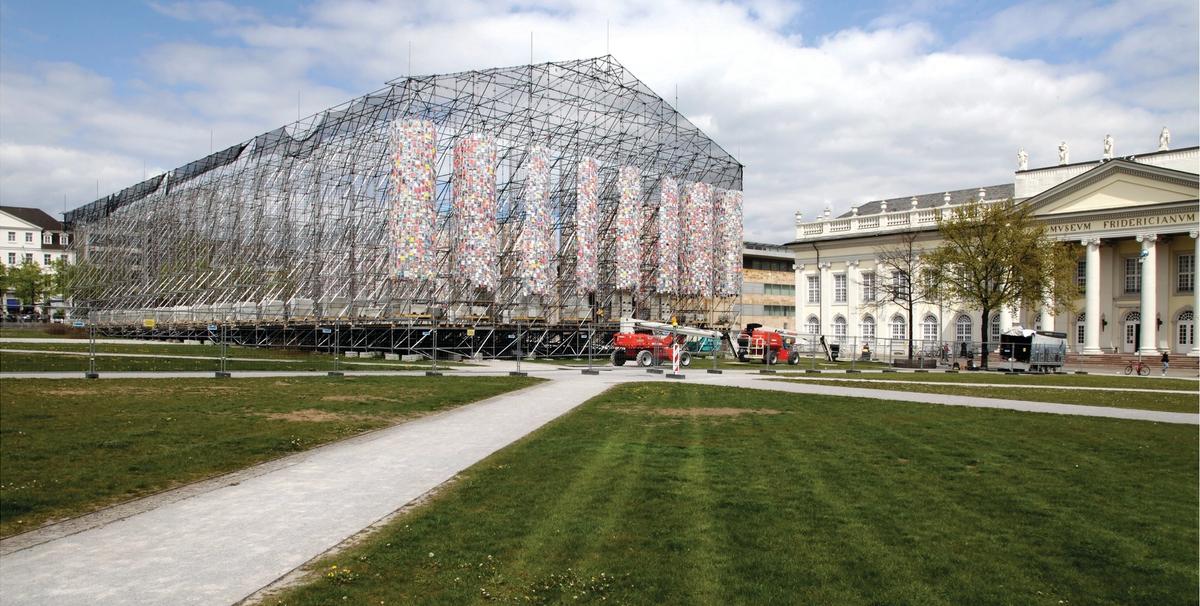To understand the idea behind any particular edition of Documenta in Kassel, visitors usually head straight to the Fridericianum. This 18th-century building, one of the world’s first purpose-built museums, is where the show’s artistic directors lay out their conceptual framework. However, visitors to the 14th edition will be walking into a Fridericianum transformed into the National Museum of Contemporary Art in Athens (EMST), presenting highlights from the Greek museum’s collection.
The move is in line with Documenta 14’s broader themes, and attempts to undermine the hierarchies of the global art world, says Dieter Roelstraete, a member of the curatorial team convened by the show’s artistic director Adam Szymczyk. It is one of several departures this year from the traditional Documenta model, following the decision to open a part of the show in Athens in April (until 16 July) before a second iteration in its usual German home (10 June-17 September). It is the first time in its 60-year history that Documenta has opened elsewhere and that its traditional 100-day running period has swelled to 163 days. EMST, which was established in 1997 but opened only late last year after financial and bureaucratic problems, is the main venue of the Athens leg.
When Szymczyk devised Documenta 14 in summer 2013, Greece was in the grips of an economic crisis and suffering the effects of painful austerity measures. As the crisis continues to strangle the country’s economy and welfare state, Szymczyk sees Athens as a vantage point for a Documenta that warns of the “deficiencies of democracy” and urges visitors “to learn how to see the world again in an unprejudiced way, unlearning and abandoning the predominant cultural conditioning that presupposes the supremacy of the West”.
An abundance of unfamiliar artists is the emphatic expression of this aim. Szymczyk urged his curatorial team to look beyond their “comfort zone”, according to Roelstraete. “Just as Documenta left the comfort zone of Kassel, so we were prompted to look beyond what we know.” Hendrik Folkerts and Candice Hopkins, two other members of the Documenta team, travelled as far as Mongolia to find artists (Ariuntugs Tserenpil and Nomin Bold are among the artists in the show). Albanian social-realist artists are also well represented in Documenta 14, “to the bafflement of some”, Roelstraete says, as are indigenous groups; all the participating Norwegian artists, for example, are Sami.
Documenta 14 is among the most historically reflective editions: works by older and deceased artists abound. It is striking that so many of the older artists in the show are women. Works by Geta Bratescu, Anna Halprin (both also represented at the Venice Biennale), Beatriz González and Cecilia Vicuña outnumber those by more youthful practitioners. “There’s a sense that we are giving these artists their due at long last because many of them have lived or led their lives in the shadow of men,” Roelstraete says. A work by an older female artist, 74-year old Marta Minujín, looks set to be a showstopper in Kassel: a huge replica of the Acropolis in Athens, made from 100,000 banned books, will be set up in the Friedrichsplatz opposite the Fridericianum. The work is a restaging of the artist’s The Parthenon of Books, which she created in Buenos Aires in 1983, shortly after the collapse of the country’s dictatorship.
Unsurprisingly for an exhibition whose themes include migration and the plight of refugees, Documenta will for the first time inhabit sites in the north of Kassel, which is home largely to immigrant communities. The show will occupy a series of glass pavilions located along a busy thoroughfare, a disused industrial warehouse on the university grounds and a former post office with a huge central space—“Kassel’s Turbine Hall, if you will”, Roelstraete says.
In the city centre, the Neue Galerie will feature works by artists including Maria Eichhorn and David Schutter that refer to the Cornelius Gurlitt affair and to looted art. The curators had hoped to exhibit Gurlitt’s entire art cache, much of which is suspected Nazi loot, but legal complications scuppered the idea. Instead, dispossession and dictatorship will “resonate in a big way throughout the building”, Roelstraete says. “In this way, the Gurlitt trove haunts the Neue Galerie.”


